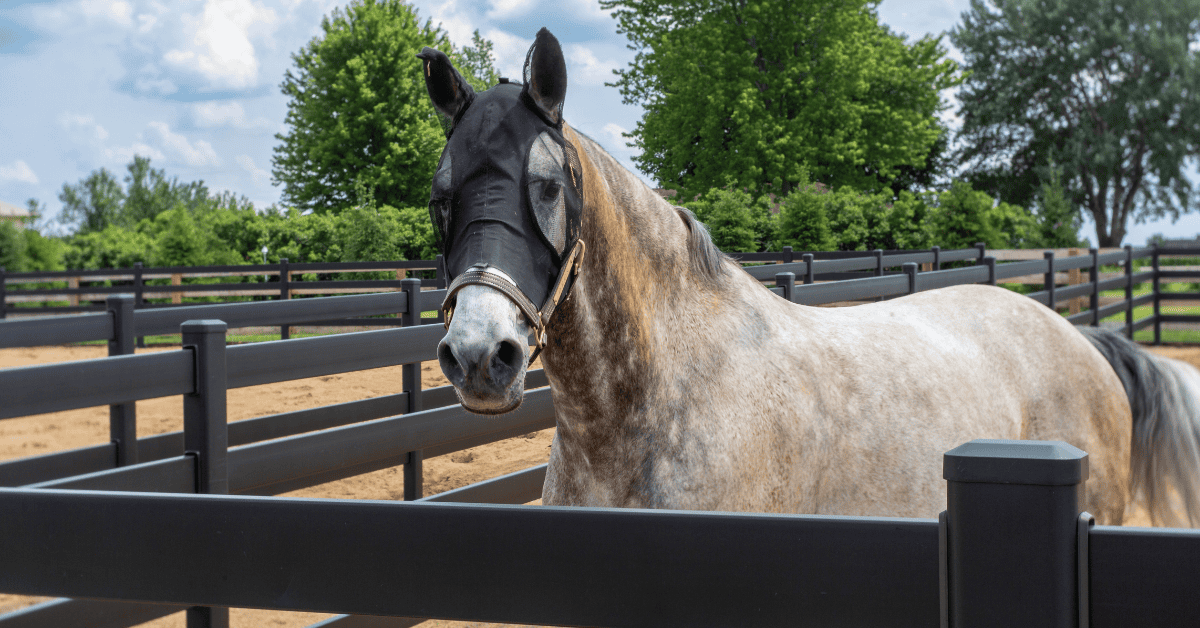Horse cribbing isn’t just an annoying habit. It’s a destructive behavior that can cost you thousands in fence repairs, compromise your horses’ health, and spread through your herd like wildfire. We’ve seen beautiful ranches turned into maintenance nightmares because owners didn’t understand what they were dealing with or how to stop it.
The worst part is that most of the “solutions” you’ll find don’t work. Cribbing collars, bitter sprays, removing every possible surface—these are Band-Aids to the problem.
Horses don’t crib because they’re trying to drive you crazy. They do it because something’s not right in their world, and they’re looking for relief the only way they know how.
Fortunately, you can stop it. Not with gimmicks or wishful thinking, but by understanding what drives the behavior and building an environment where horses don’t need to start cribbing in the first place. Get the management right, fix the real problems, and use fencing that doesn’t hand them an invitation to destroy your property.
When you know what you’re fighting and how to fight it smartly, you protect everything that matters: your horses and your investment.
What Is Horse Cribbing?
Horse cribbing is a compulsive behavior where horses grab onto solid objects (like fence rails) with their teeth, arch their neck, and suck in air while making a distinctive gulping sound. This endorphin-releasing habit becomes addictive and can spread to other horses in the herd.
It’s not eating. It’s not playing. It’s a compulsion that becomes as automatic as scratching an itch.
The process is always the same: grab, arch, gulp.
Cribbing releases endorphins in your horse’s brain. Those are the same feel-good chemicals that make exercise addictive in people. So when your horse cribs, he’s essentially getting his high. That’s why it becomes compulsive, and that’s why it’s so hard to stop once it starts.
Don’t confuse cribbing with wind-sucking, though they often get lumped together. Wind-sucking horses arch their necks and gulp air without grabbing onto anything. Cribbing horses need something to bite down on (which is exactly why your fencing becomes their favorite target).
The behavior typically starts when horses are young, stressed, or bored. But once that neural pathway gets carved into their brain, it becomes a go-to response for everything from anxiety to plain old habit. It’s like a smoker reaching for cigarettes: automatic, compulsive, and destructive.
Watch a cribbing horse long enough, and you’ll see the pattern. They’ll work their way down a fence line, testing different spots, wearing grooves into the wood where they grab repeatedly. Those grooves aren’t just cosmetic damage, either. They’re evidence of a behavior that’s about to cost you serious money and potentially your horse’s health.
Other horses watch and learn. Cribbing spreads through a herd faster than bad news, especially among young or stressed animals looking for their own way to cope.
The Damage Cribbing Causes (to Horses & Property)
Your horses pay the biggest price. Constant cribbing wears down their front teeth faster than stones in a rock tumbler. We’re talking about severe dental damage that affects their ability to graze properly and can lead to serious weight loss.
The constant air gulping increases colic risk, and horses that crib often struggle to maintain good body condition no matter how well you feed them.
Your property takes a beating too. Cribbing horses will systematically destroy wooden fencing, creating splintered edges and weakened rails that become safety hazards. They’ll chew through gate tops, barn stall fronts, and any wooden surface they can reach.
Ranchers with cribbing horses might need to spend thousands annually just replacing fence boards that get demolished by chronic cribbers.
What starts as one horse’s bad habit can become a herd-wide problem that turns your entire property into a maintenance nightmare. One cribbing horse can teach five others, multiplying your headaches and your repair bills.
What Doesn’t Work (And Why)
Most folks reach for quick fixes when they spot cribbing, but these solutions are about as effective as putting a screen door on a submarine. Here’s what sounds good in theory but fails miserably in practice:
- Cribbing collars: These leather or metal contraptions around the horse’s throat are supposed to prevent the neck arching motion. Problem is, they cause welfare concerns, can interfere with normal swallowing, and many horses figure out how to crib around them anyway.
- Bitter sprays and deterrents: You’ll spray every surface with apple-bitter or hot sauce thinking it’ll stop them. Horses adapt to these tastes faster than you can reapply them, and rain washes them away before they’ve done any good.
- Removing all grippable surfaces: Some folks try to eliminate every fence rail, gate edge, and post top their horse might grab. This is impossible unless you want to live with your horses in a padded room, and it actually increases their stress levels.
- Punishment and scolding: Yelling at a cribbing horse or trying to startle them when they start only adds anxiety to whatever’s already driving the behavior. You’re treating the symptom while making the disease worse.
- Electric wire on fence tops: Horses learn to crib right next to the wire without touching it, or they’ll simply move to un-electrified surfaces elsewhere on your property.
The truth is, none of these address why horses start cribbing in the first place.
Cribbing-Prevention Solutions That Actually Work
When you get serious about stopping cribbing, you’ve got to address the root causes and remove the opportunities. Here’s what actually works when you do it right:
- Maximize turnout and social interaction: Horses evolved to roam and graze with others 20 hours a day. The more time they spend in natural behaviors, the less likely they are to develop compulsive ones. Extended pasture time with other horses cuts cribbing risk dramatically.
- Provide constant forage access: Slow-feed hay nets, multiple feeding stations, and grazing opportunities keep horses occupied with what they’re supposed to be doing—eating. When their minds and mouths are busy with food, they’re not looking for fence rails to grab.
- Address digestive health issues: Ulcers and digestive discomfort drive many horses to crib as a coping mechanism. Work with your vet to identify and treat underlying health problems, especially gastric ulcers.
- Create mental stimulation: Bored horses find their own entertainment, and it’s usually not what you want. Toys, varied terrain, and enrichment activities give them constructive outlets for their curiosity and energy.
Steel Board Fencing: The Ultimate Cribbing Solution
Wood fencing is basically an invitation for horses to start cribbing. Those rough-textured boards with their satisfying “give” when bitten are exactly what horses are looking for when they want to grab and pull. The material has just enough flex to feel rewarding when they bite down, and every time they damage it, they create even more appealing rough edges and splinters.
Our steel board fencing eliminates the fundamental appeal. The smooth, rounded edges give horses nothing to grip. There’s no satisfying wood texture, no “give” when they bite, and no rough surfaces that encourage the behavior. When horses can’t get that physical satisfaction from trying to crib, they simply stop attempting it.
Steel board systems maintain their smooth integrity regardless of weather or horse interaction. Unlike wood that splinters and creates new gripping opportunities, steel stays consistently smooth and uninviting to cribbing behavior.
We’ve seen chronic cribbers move to properties with steel board fencing and gradually abandon the behavior because they can’t find surfaces that satisfy their compulsion. It’s not punishment: it’s simply removing the opportunity while providing better outlets for their natural behaviors.
This isn’t about fighting your horses’ instincts. It’s about creating an environment where those instincts don’t drive them toward destructive behaviors in the first place.
Stop Cribbing Before It Starts
Cribbing isn’t just going to go away on its own. Everyday you wait is another day of fence damage, another chance for the behavior to spread through your herd, and another step closer to serious health problems in your horses.
Your horses deserve better than a cycle of stress, boredom, and destructive habits. Your property deserves better than constant repairs and maintenance headaches. And you deserve better than lying awake wondering what damage you’ll find in the morning.
Put an end to your cribbing worries (for good) with steel board fencing.
The investment in proper fencing and management pays for itself in saved repair costs, healthier horses, and peace of mind. More importantly, it protects everything you’ve worked to build.
Your horses are counting on you to get this right. Let’s make sure you do. Reach out, and let’s find a solution that works for you (and your horses).



